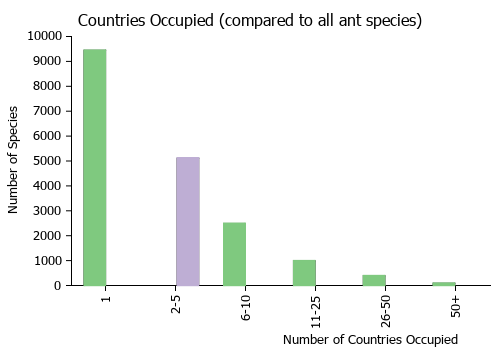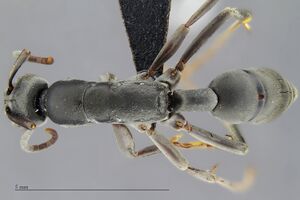Platythyrea arnoldi
| Platythyrea arnoldi | |
|---|---|

| |
| Scientific classification | |
| Kingdom: | Animalia |
| Phylum: | Arthropoda |
| Class: | Insecta |
| Order: | Hymenoptera |
| Family: | Formicidae |
| Subfamily: | Ponerinae |
| Tribe: | Platythyreini |
| Genus: | Platythyrea |
| Species: | P. arnoldi |
| Binomial name | |
| Platythyrea arnoldi Forel, 1913 | |
| Synonyms | |
| |
| At a Glance | • Gamergate |
Identification
Keys including this Species
Distribution
Latitudinal Distribution Pattern
Latitudinal Range: -4.2875° to -29.65°.
| North Temperate |
North Subtropical |
Tropical | South Subtropical |
South Temperate |
- Source: AntMaps
Distribution based on Regional Taxon Lists
Afrotropical Region: Democratic Republic of Congo, Mozambique, South Africa, Zimbabwe (type locality), Zimbabwe (type locality).
Distribution based on AntMaps
Distribution based on AntWeb specimens
Check data from AntWeb
Countries Occupied
| Number of countries occupied by this species based on AntWiki Regional Taxon Lists. In general, fewer countries occupied indicates a narrower range, while more countries indicates a more widespread species. |

|
Estimated Abundance
| Relative abundance based on number of AntMaps records per species (this species within the purple bar). Fewer records (to the left) indicates a less abundant/encountered species while more records (to the right) indicates more abundant/encountered species. |

|
Biology
Castes
       
| |
| . | Owned by Museum of Comparative Zoology. |
   
| |
| . | |
Nomenclature
The following information is derived from Barry Bolton's Online Catalogue of the Ants of the World.
- arnoldi. Platythyrea arnoldi Forel, 1913j: 206 (w.) ZIMBABWE.
- Type-material: syntype workers (number not stated).
- Type-locality: Zimbabwe (“South Rhodesia”): Shiloh (G. Arnold).
- Type-depositories: MHNG, NHMB.
- Arnold, 1926: 197 (q.m.).
- Status as species: Arnold, 1915: 28; Wheeler, W.M. 1922a: 758; Arnold, 1926: 197; Brown, 1975: 8, 47; Bolton, 1995b: 336; Hita Garcia, et al. 2013: 221.
- Senior synonym of apicalis: Brown, 1975: 8; Bolton, 1995b: 336.
- Distribution: Kenya, Zimbabwe.
- apicalis. Platythyrea lamellosa st. apicalis Santschi, 1937g: 71, fig. 1a-b (w.) DEMOCRATIC REPUBLIC OF CONGO.
- [Note: Santschi’s fig. 1 is incorrectly labelled as Leptogenys.]
- Type-material: holotype worker.
- Type-locality: Democratic Republic of Congo (“Congo belge”): Nyangwe, viii.1932 (L. Lebrun).
- Type-depository: NHMB.
- Junior synonym of arnoldi: Brown, 1975: 8; Bolton, 1995b: 336.
Description
References
- Arnold, G. 1926. A monograph of the Formicidae of South Africa. Appendix. Ann. S. Afr. Mus. 23: 191-295 (page 197, queen, male described)
- Brown, W. L., Jr. 1975. Contributions toward a reclassification of the Formicidae. V. Ponerinae, tribes Platythyreini, Cerapachyini, Cylindromyrmecini, Acanthostichini, and Aenictogitini. Search Agric. (Ithaca N. Y.) 5(1 1: 1-115 (page 8, Senior synonym of apicalis)
- Forel, A. 1913k. Ameisen aus Rhodesia, Kapland usw. (Hym.) gesammelt von Herrn G. Arnold, Dr. H. Brauns und Anderen. Dtsch. Entomol. Z. 1913(Su Suppl: 203-225 (page 206, worker described)
- Villet, M. 1993. Co-occurrence of mated workers and a mated queen in a colony of Platythyrea arnoldi (Hymenoptera: Formicidae). S. Afr. J. Zool. 28: 56-57.
References based on Global Ant Biodiversity Informatics
- Arnold G. 1915. A monograph of the Formicidae of South Africa. Part I. Ponerinae, Dorylinae. Annals of the South African Museum 14: 1-159.
- Arnold G. 1926. A monograph of the Formicidae of South Africa. Appendix. Annals of the South African Museum. 23: 191-295.
- Garcia F.H., Wiesel E. and Fischer G. 2013.The Ants of Kenya (Hymenoptera: Formicidae)Faunal Overview, First Species Checklist, Bibliography, Accounts for All Genera, and Discussion on Taxonomy and Zoogeography. Journal of East African Natural History, 101(2): 127-222
- IZIKO South Africa Museum Collection
- Wheeler W. M. 1922. Ants of the American Museum Congo expedition. A contribution to the myrmecology of Africa. VIII. A synonymic list of the ants of the Ethiopian region. Bulletin of the American Museum of Natural History 45: 711-1004

